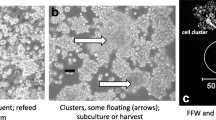Summary
The upper thermal limit for maintenance of eleven mosquito cell lines was studied. Although most cell lines could be grown at 32°C to 34°C,Anopheles stephensi cell line could be maintained at 37°C. At higher temperatures initial growth rate was higher, but yield of cells after about a week of incubation was lower than at the standard temperature (28°C). Replication of several flaviviruses inAedes albopictus cell cultures adapted to 34.5°C was faster, and viral titers were higher than at 28°C.
Similar content being viewed by others
References
Brock, T. D. Life at high temperatures. Science 230:132–138; 1985.
Carvalho, M. G. C.; Rebello, M. A. Induction of heat shock proteins during the growth ofAedes albopictus cells. Insect Biochem. 17:199–206; 1987.
Chen, T. R. In situ demonstration of mycoplasma contamination in cell cultures by fluorescent Hoechst 33258 Stain. Exp. Cell Res. 104:255–262; 1977.
Corner, L. C.; Ng, M. C. The influence of higher temperature on dengue-2 virus infected C6/36 mosquito cell line. Canad. J. Microbiol. 33:863–869; 1987.
Durbin, R. K.; Stollar, V. Sindbis virus mutants able to replicate in methionine-derivedAedes albopictus cells. Virology 144:529–533; 1985.
Hink, W. F. A complication of invertebrate cell lines and culture media. In: Maramorosch, K. ed. Invertebrate tissue culture: research application. New York: Academic Press; 1976:319–369.
Igarashi, A. Isolation of Singh'sAedes albopictus cell clone sensitive to dengue and chikungunya viruses. J. Gen. Virol. 40:531–544; 1978.
Jozan, M. Of arboviruses, arthropods, and arthropod cell cultures: history and expectations. In: Yunker, C. E. ed. Arboviruses in arthropod cells in vitro. Vol. 1. Boca Raton, Florida: CRC Press; 1987:3–22.
Kuno, G. Dengue virus replication in a polyploid mosquito cell culture grown in serum-free medium. J. Clin. Microbiol. 16:851–855; 1982.
Lam, S. K.; Chew, C. B.; Poon, G. K., et al. Isolation of dengue viruses by intracerebral inoculation of mosquito larvae. J. Virol. Methods 14:133–140; 1986.
Marhoul, Z.; Pudney, M. A mosquito cell line (Mos 55) from Anopheles gambiae larvae. Trans. R. Soc. Trop. Med. 66:183–184; 1972.
McLean, D. M.; Clarke, A. M.; Coleman, J. C., et al. Vector capability ofAedes aegypti mosquitoes for California encephalitis and dengue viruses at various temperatures. Canad. J. Microbiol. 20:255–262; 1974.
Oro, G. Establishment of a Mosquito Cell Line, fromHaemagogus equinus larvae. In Vitro 20:153–156; 1984.
Pudney, M.; Leake, C. J.; Buckley, S. M. Replication of arboviruses in arthropod in vitro systems: an overview. In: Maramorosch, K.; Mitsuhashi, J., eds. Invertebrate Cell Culture Applications. London: Academic Press; 1982:159–194.
Pudney, M.; Varma, M. G. R.Anopheles stephensi var.mysorensis: establishment of a larval cell line (Mos. 43). Exptl. Parasitol. 29:7–12; 1971.
Renz, D.; Brown, D. T. Characteristics of Sindbis virus temperature-sensitive mutants in cultured BHK-21 andAedes albopictus (Mosquito) cells. J. Virol. 19:775–781; 1976.
Russell, P. K.; Nisalak, A. Dengue virus identification by the plaque reduction neutralization test. J. Immunol. 99:291–296; 1967.
Singh, K. R. P. Cell cultures derived from larvae ofAedes albopictus (Skuse) andAedes aegypti (L.) Current Science 36:506–508; 1967.
Tesh, R. B. A method for the isolation and identification of dengue viruses, using mosquito cell cultures. Am. J. Trop. Med. Hyg. 28:1053–1059; 1979.
Varma, M. G. R.; Pudney, M. The growth and serial passage of cell lines fromAedes aegypti (L.) larvae in different media. J. Med. Entomol. 6:432–439; 1969.
Varma, M. G. R.; Pudney, M.; Leake, C. J. Cell lines from larvae ofAedes (Stegomyia) malayensis Coless andAedes (S.)pseudoscutellaris (Theobald) and their infection with some arboviruses. Trans. R. Soc. Trop. Med. Hyg. 68:374–382; 1974.
Watts, D. M.; Burke, D. S.; Harrison, B. A., et al. Effect to temperature on the vector efficiency ofAedes aegypti for dengue 2 virus. Am. J. Trop. Med. Hyg. 36:143–152; 1987.
Zerbini, M.; Musiani, M.; La Placa, M. Stimulating effect of heat shock on the early stage of human cytomegalovirus replication cycle. Virus Research 6:211–216; 1986.
Zhu, G.; Liu, Z.; Wang, J. Improved technique for dengue virus micro cell culture. Chinese Med. J. 97:73–73; 1984.
Author information
Authors and Affiliations
Rights and permissions
About this article
Cite this article
Kuno, G., Oliver, A. Maintaining mosquito cell lines at high tempetatures: Effects on the replication of flaviviruses. In Vitro Cell Dev Biol 25, 193–196 (1989). https://doi.org/10.1007/BF02626177
Received:
Accepted:
Issue Date:
DOI: https://doi.org/10.1007/BF02626177




